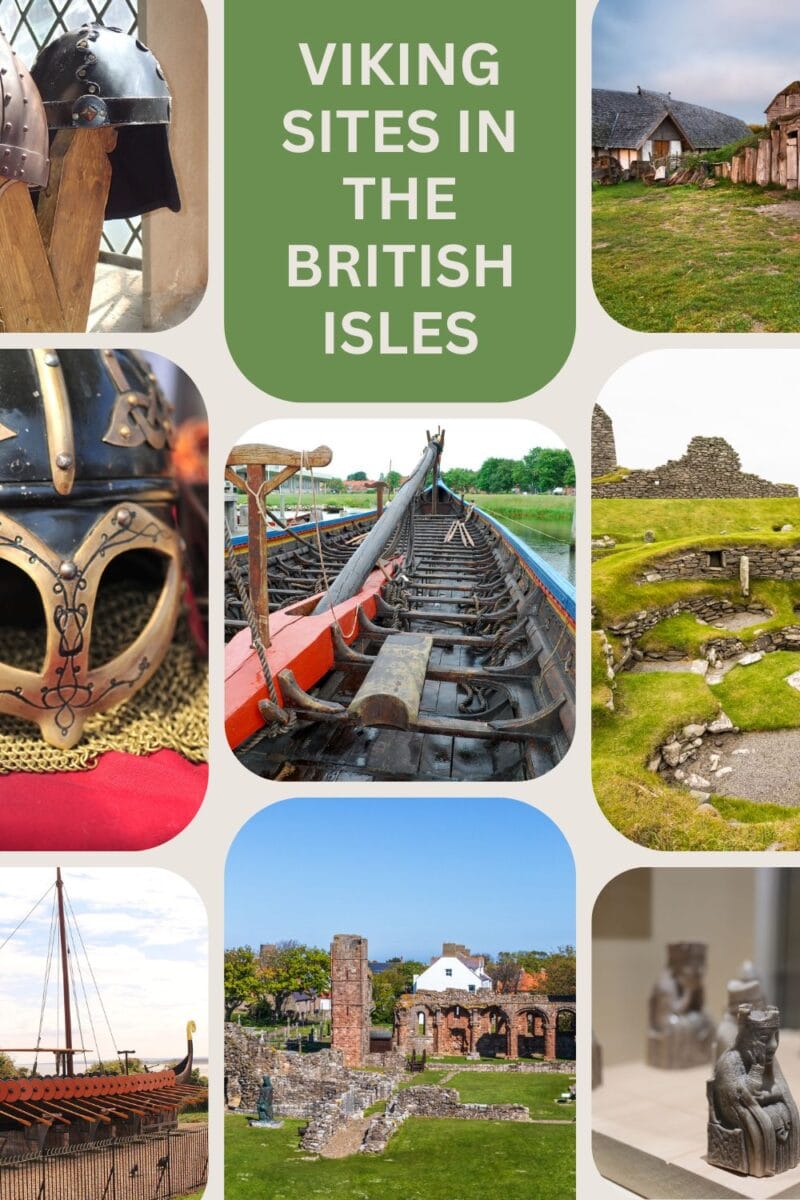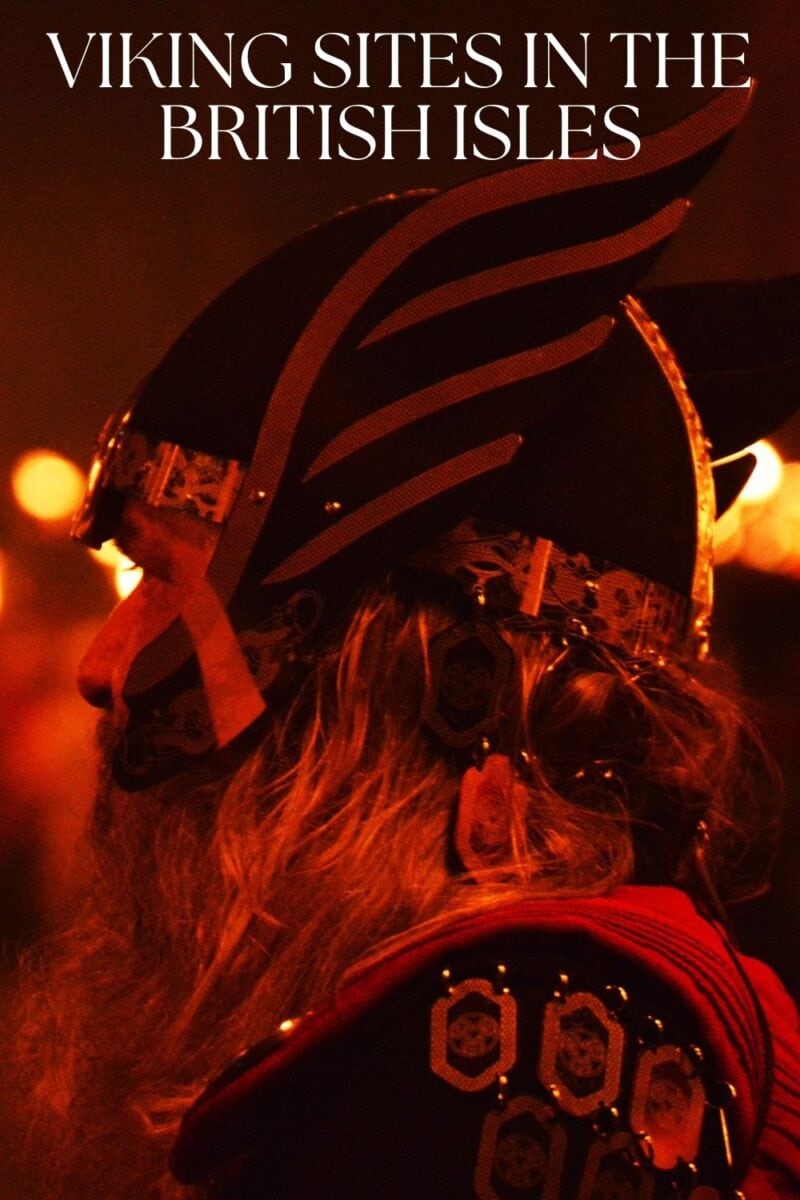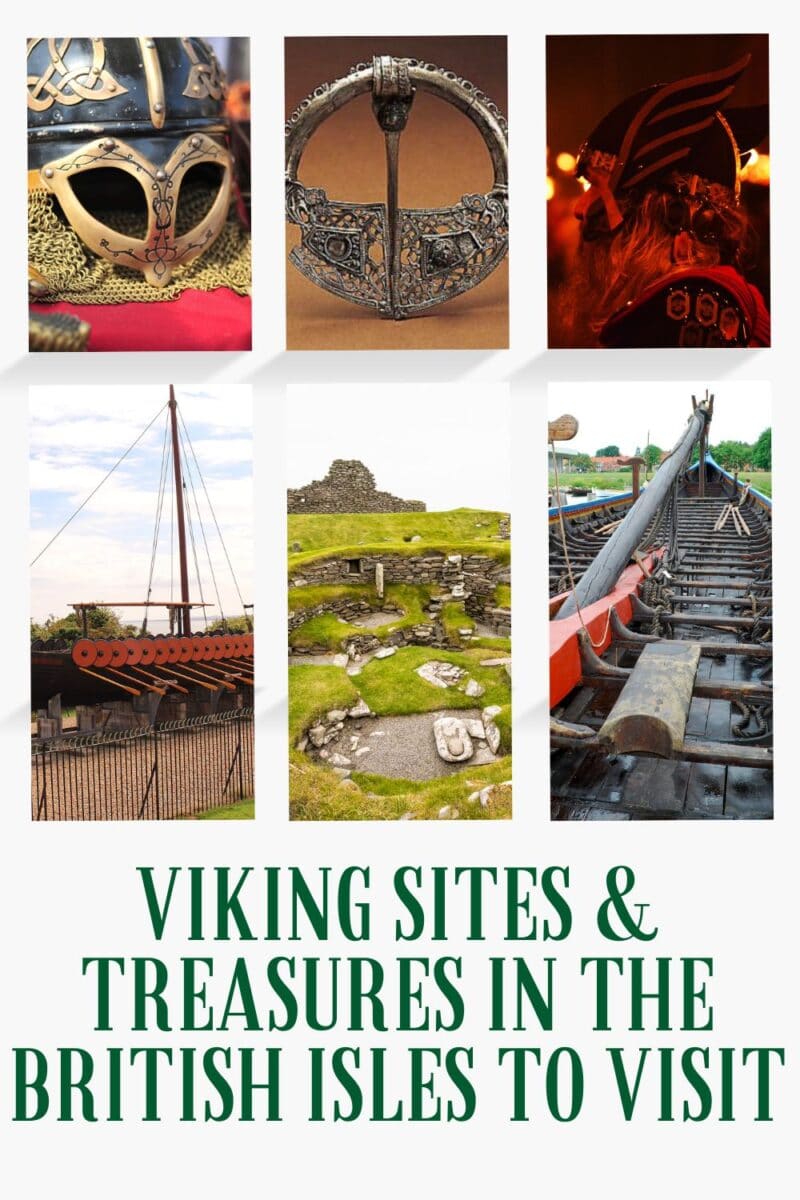Best Viking sites in the British Isles to visit
The world has been obsessed with Vikings long before the HBO TV Series The Vikings and exploring the history of Vikings by amateurs and professionals in the UK has long turned up hoards of silver and artefacts including coins, jewellery, swords and shields.
The Viking Age in the UK lasted from around 800-1150 AD and the first invasion was the monastery at Lindisfarne in Northumberland (Northern England today)in 793. The first written tale of the Viking invasion of the British Isles was in Portland, Dorset in 789. The last Vikings invaded the UK after the Battle of Hastings in 1066 when the Norman Invasion began by William the Conqueror who became King of England. This was rather ironic as William was in truth another Viking descended from Rollo who invaded Normany in France.
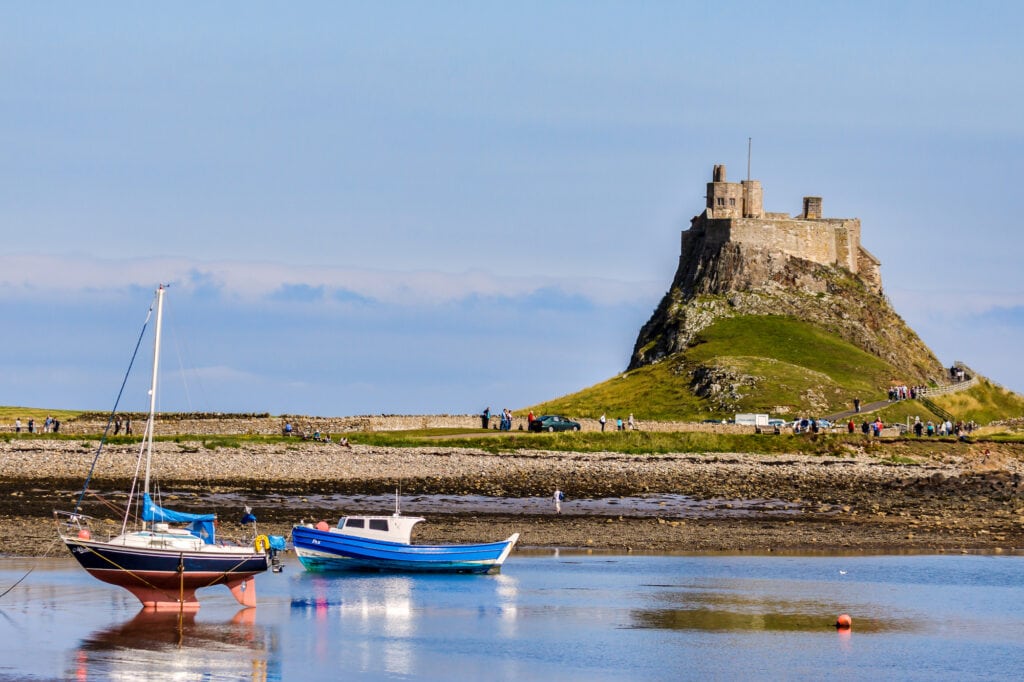
Obviously, ancient Viking ruins are relatively rare in Britain as the compounds and villages would have been dominantly built from wood and materials that melt away over the centuries, but many an amateur with a metal detector has turned up significant Viking UK finds.
- Best Viking sites in the British Isles to visit
- History of the Vikings invasion of Britain
- Viking Sites to Visit in the British Isles – FAQ
- 1. What are some prominent Viking sites to visit in the British Isles?
- 2. How did the Vikings influence the British Isles?
- 3. What was the significance of the Viking presence in Northern England?
- 4. How did the Viking invasions impact the course of English history?
- 5. What can visitors learn about the Vikings by visiting sites in the British Isles?
- A brief history of the Viking invasion of England
- The Danelaw UK
- Harald Hardrada
- 24 Viking settlements UK
- Vikings in England
- Lindisfarne Priory – Northumberland
- Jorvik Viking Centre – Viking museum in York
- Yorkshire Museum – York
- House of Manannan – Isle of Man
- The Dock Museum – Barrow in Furness Cumbria
- Silverdale Hoard – Lancashire
- Ancient Technology Centre – Dorset
- British Museum – London
- The Ashmolean Museum – Oxford
- Viking burial ground Derbyshire – The Repton warrior
- Norwich Castle Museum
- The Hugin Viking Longship – Kent
- Vikings in Scotland
- Iona
- Vikings in Wales
History of the Vikings invasion of Britain
The Viking age in Britain lasted from approximately 800 to 1150 AD.
Historians tend to disagree about the origin of the word “Viking”. Anglo-Saxons called them many names including Northmen, Norsemen, Danes and more picturesque names like sea-rovers, sea wolves or simply the heathen.

Viking as a word actually comes from an old Norse word Vik which means inlet or vikja which means to move quickly.
The Viking influence on Britain was immense as we incorporated their names for the days of the week from the Norse gods – Thor = Thursday, Odin = Wednesday, Tuesday from Tiw or Tyr and so on. The Vikings also gave us words such as fog, bread, steak and even egg.
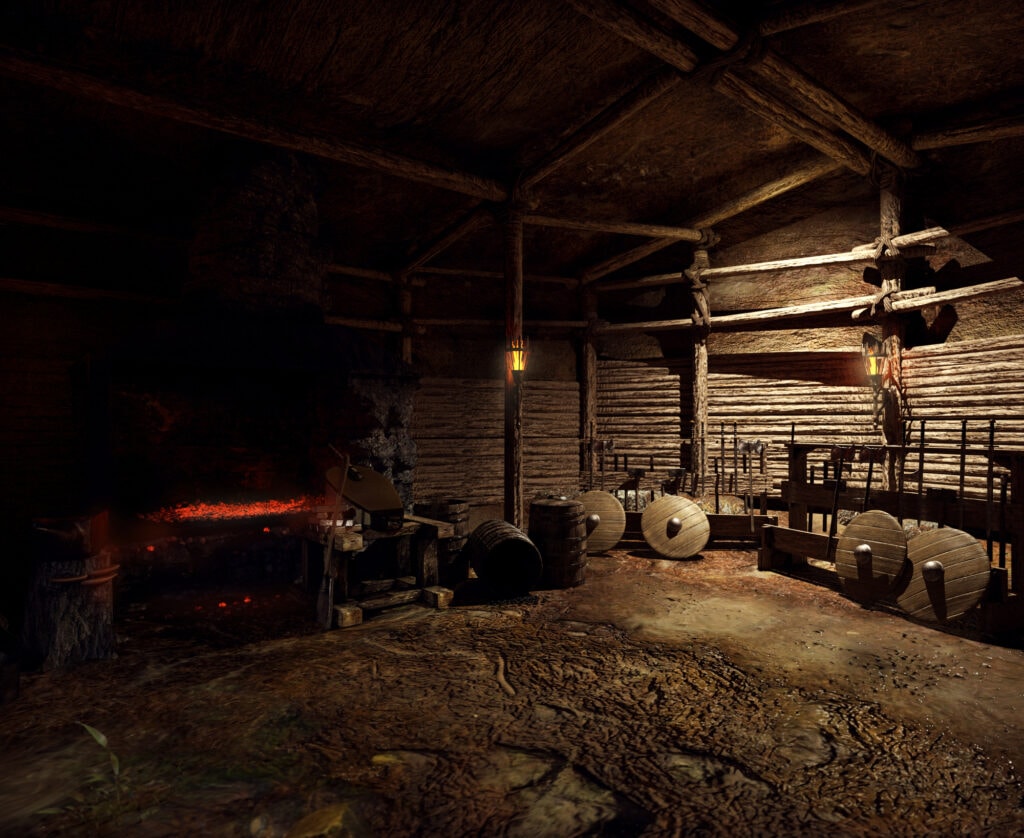
Viking Sites to Visit in the British Isles – FAQ
1. What are some prominent Viking sites to visit in the British Isles?
There are several Viking sites in the British Isles that offer a glimpse into the Viking Age history. Some notable locations include Lindisfarne in England, The Jorvik Viking Centre in York and in Derbyshire you can visit the Repton man.
2. How did the Vikings influence the British Isles?
The Vikings had a significant impact on the British Isles through raids, settlements, and cultural exchanges. They played a crucial role in shaping the history of the British Isles during the Viking Age.
3. What was the significance of the Viking presence in Northern England?
The Vikings had a strong presence in Northern England during their invasions. Places like York served as important Viking centers, showcasing their territorial expansions in the region.
4. How did the Viking invasions impact the course of English history?
The Viking invasions in England led to conflicts, political changes, and ultimately, the establishment of the Danelaw. These events have been pivotal in shaping English history and the Anglo-Saxon society of the time.
5. What can visitors learn about the Vikings by visiting sites in the British Isles?
Visiting Viking sites in the British Isles provides insights into their trade networks, social structures, beliefs, and the strategic importance of certain locations during the Viking Age.
Map of Viking Settlements in UK

A brief history of the Viking invasion of England
When was the first Viking raid in the UK?
Viking activity in the British Isles occurred during the Early Middle Ages, the 8th to the 11th centuries CE, when Scandinavians travelled to the British Isles to raid, conquer, settle and trade. It was believed that the Viking invasion began in England in the late 8th century, primarily on monasteries. The first Viking raid was at the monastery on the Holy Island of Lindisfarne in 793, off the northeast coast, and the first recorded Viking attack was at Portland, Dorset in 787. The first known account of a Viking raid in Anglo-Saxon England comes from 789, when three ships from Hordaland (in modern Norway) landed in the Isle of Portland on the southern coast of Wessex.
According to the Anglo-Saxon Chronicle, which was written in the late ninth century probably in the Kingdom of Wessex during the reign of Alfred the Great. The Viking invasion of England began in 787 when three ships landed at Portland Dorset. The King’s man Beaduheard, went out to meet these traders (which he assumed they were). Beaduheard attempted to bring them to the King’s town which was the custom but the Vikings killed him and his guards.

The first Viking raid on a monastery took place in 793. The Vikings landed on the holy island of Lindisfarne and from there regular raids were conducted around the British Isles by the Vikings. Monasteries were often a target due to the precious items kept within them. The Vikings plundered for gold, and silver including crucifixes, chalices, bowls and cups.
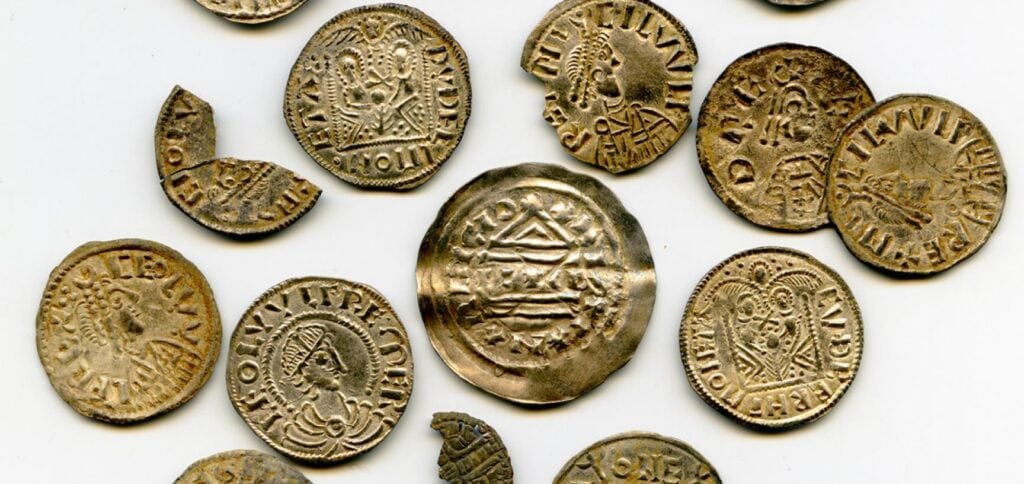
Two years later, Viking raids struck the undefended island monasteries of Skye and Iona in the Hebrides, Scotland as well as Rathlin Island off the northeast coast of Ireland.
Vikings in Britain locations
Over time these Viking raiders began to set up camps and then settled on the land seized to build farming communities. In the north of Britain, the Vikings settled in Orkney, the Hebrides and Shetland and all along the north and northwest coast of Scotland.
The Vikings moved west and took over the Isle of Man and went on to found Dublin, Cork, Limerick and Waterford.
In 842 AD London was attacked by the Vikings and again in 851. It was Alfred the Great who forced the Vikings into a peace treaty in 886 when he battled them at Edington and won. The treaty agreed upon divided England between the Vikings and the English and the Viking territory became known as the Danelaw.
In England, the Vikings took East Anglia, Northumbria and parts of Mercia. In 866 they captured York and made it their capital naming it Jorvik.

The Danelaw UK
The Danelaw was made up of the northwest, the northeast and east of England. It wasn’t until 937 that King Athelstan claimed victory at the Battle of Brunaburch when Eirik Bloodaxe the last Viking King of York was killed and the English earls reclaimed the Kingdom.
The Viking army did not stop their raids and made regular incursions into Britain and actually had four kings between 1013 and 1042. King Cnut, was the most famous of Vikings in England he was king of Denmark as well as of England. Cnut was a Christian and he recognized Anglo-Saxon law and customs but he died at the age of 39 and his kingdom fell into disarray by 1035.
Harald Hardrada
In 1066 the Viking Harald Hardrada sailed up the Humber in an attempt seize the English throne but he was defeated in battle by King Harold at the battle of Stamford Bridge. Hardrada thought he could take over England during the succession dispute which followed the death of Edward the Confessor.
Hardrada was killed in this battle along with his great heathen army and Immediately after King Harold defeated the Norse he had to turn to Kent and the Battle for control of England by the Normans at the Battle of Hastings in 1066 which is depicted on the world-famous Bayeux Tapestry. At the end of the battle, Harold was dead and William the Conqueror was the King of England. William himself was descended from the Viking Rollo who had invaded Normandy in Northern France in 911. Hardrada’s invasion and defeat has been described as the end of the Viking Age in Britain.
These are the best places to marvel at Viking artefacts and discover the treasures, terrors and influence they had on Britain. The Viking settlers in the British Isles left remains of their material culture behind, which archaeologists have been able to excavate and interpret during the 20th and 21st centuries.
24 Viking settlements UK
Vikings in England
The history of the Vikings in England begins with the invasion of Vikings to the holy island of Lindisfarne and its famous Priory.
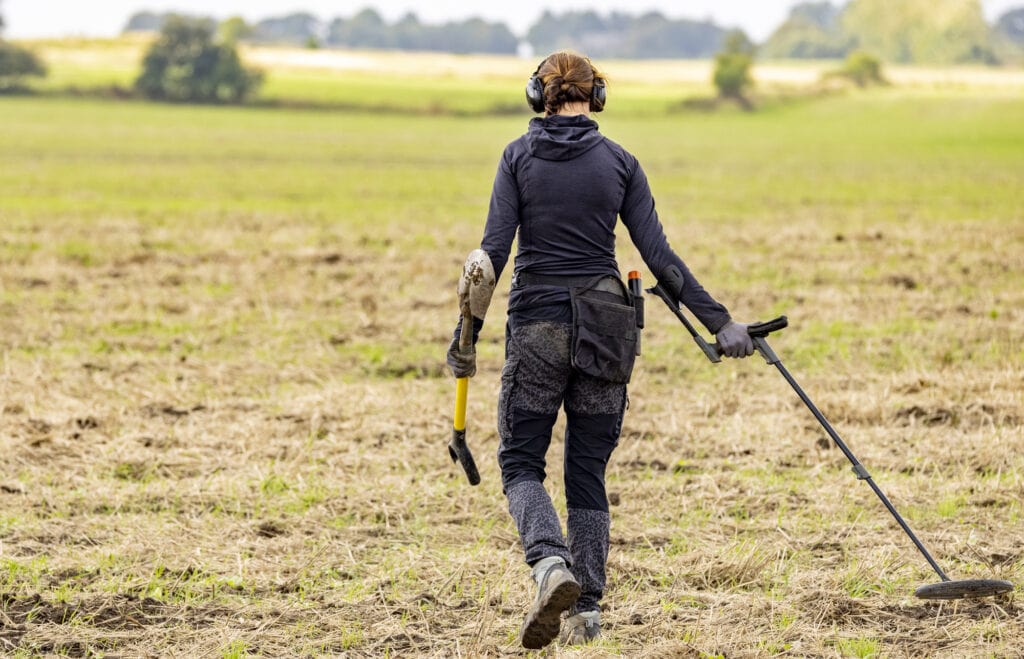
Lindisfarne Priory – Northumberland
Lindisfarne was the site of the first recorded Viking raids on British soil and the beginning of the Viking invasion of Britain and should be your first stop on a Viking discovery journey.
In 635AD Saint, Aidan came from Iona and chose to found his monastery on the island of Lindisfarne. The first recorded Viking attack in history took place on Lindisfarne in 793a.d.

You cross the dramatic causeway to reach the island of Lindisfarne, keeping an eye on the tides, and you can follow in the footsteps of the ancient monks who built their priory here nearly 1,400 years ago. A visit to the fascinating museum where you can find out about a grisly Viking raid, the cult of St Cuthbert, and the beautiful medieval manuscript: the Lindisfarne Gospels.
You will also find items including the grave markers in both letters and runes as well as one, known as the Viking Domesday Stone, which shows several men brandishing weapons.
Jorvik Viking Centre – Viking museum in York
In the 1970s a re-development was planned at Coppergate York one of the city’s medieval streets where a small dig had already highlighted massive archaeological potential.
Within a few days of the redevelopment work traces of the first Viking village in England. Viking buildings and artefacts began to be uncovered and a substantial excavation was set up. In 1976 a team of both professional and amateur archaeologists began to dig and for the next 4 years, they unearthed an enormous find of over 40,000 artefacts from Coppergate.

The teams found rare traces of Viking buildings, tons of animal bones, and thousands of pieces of Roman and Medieval items. The Jorvik Viking Centre is much more than a simple museum display. The centre takes you back to the eighth century to bring history alive with a ride that takes you through ancient Viking age Britain with animatronic Viking traders, hunters, village folk and more.
The Centre is built on a key part of the original Jorvik city and you will travel 6 metres underground to discover the remains of the walls of the historic city. With the use of modern touchscreens and films projected onto the walls, you can see the discoveries of the archaeologists of the 1970s.
Yorkshire Museum – York
The Yorkshire Museum is home to one of the greatest Viking discoveries The Vale of York Viking Hoard. Discovered in 2007 by metal detectorists the Hoard contains 617 coins, 67 gold and silver artefacts including an extremely rare gold arm-ring.
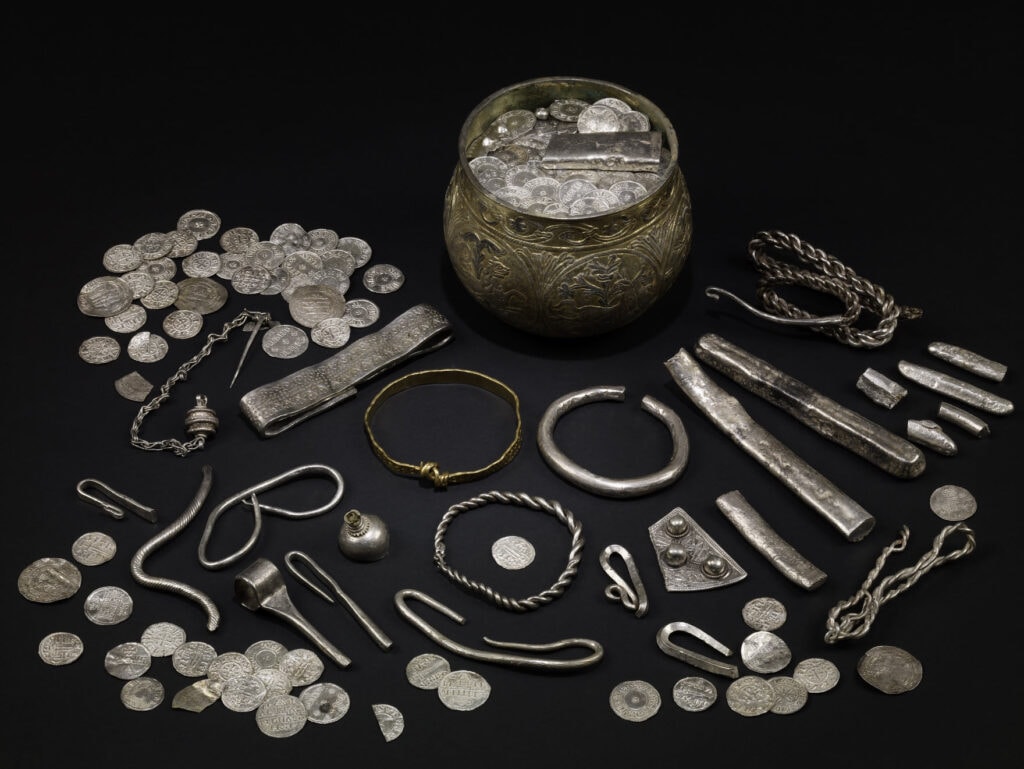
House of Manannan – Isle of Man
On the Isle of Man, you have to see the House of Manannan in Peel which uses reconstructions, characters, sights and smells to demonstrate how Celtic and Viking cultures merged together on the Island.

There is a life-size reconstruction of a Celtic roundhouse a replica of a Viking longship Odin’s Raven and replicas of the stone crosses that cover the island. Visit a replica Viking longhouse from Cronk ny Merriu an outpost from the edges of the Island.
The Dock Museum – Barrow in Furness Cumbria
The Dock Museum contains a huge collection of Viking treasures called the Furness Hoard that was discovered in 2011.
The Hoard is the largest collection of Viking treasures ever found in the area and consists of 92 silver coins, arm rings and many ingots and artefacts such as swords, weights and a spindle whorl.
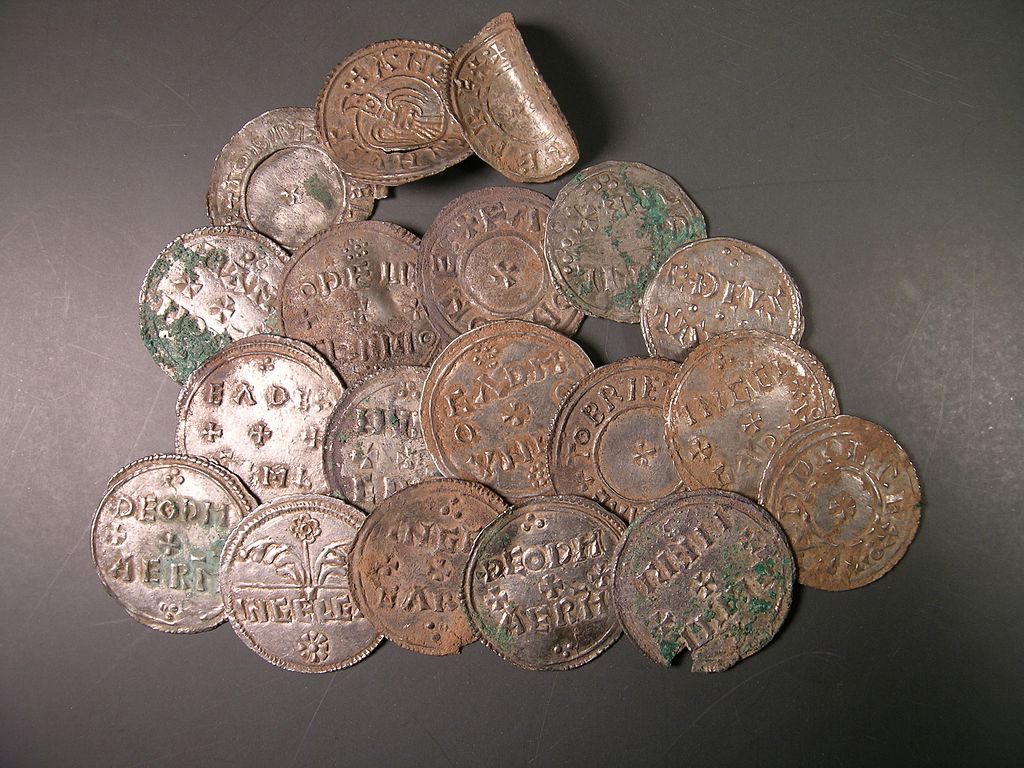
Silverdale Hoard – Lancashire
The Silverdale Hoard is a collection of over 200 pieces of silver jewellery and coins discovered near Silverdale, Lancashire, England, in September 2011. Valued at £110,000, the collection, found in a field near Silverdale by a metal detectorist, is one of the largest Viking hoards ever discovered in the UK, and is believed to date to around 900AD.
Items include 27 coins, 10 arm rings, 2 finger-rings, 14 ingots, 6 brooch fragments, a fine wire braid and 141 fragments of arm rings and ingots which had been chopped up and turned into “hack silver”, which were used as a form of currency in Viking times.

Ancient Technology Centre – Dorset
The Ancient Technology Centre gives visitors a chance to stay overnight in a Viking longhouse where you can spend the day in authentic Viking garb making fences, tending to the animals, and doing the ancient chores of a Viking. The Centre’s 26-metre, bow-sided Viking longhouse, is constructed with traditional materials and techniques to provide a truly immersive experience.
The learning centre teaches visitors about the techniques and technologies that went into ancient house building.
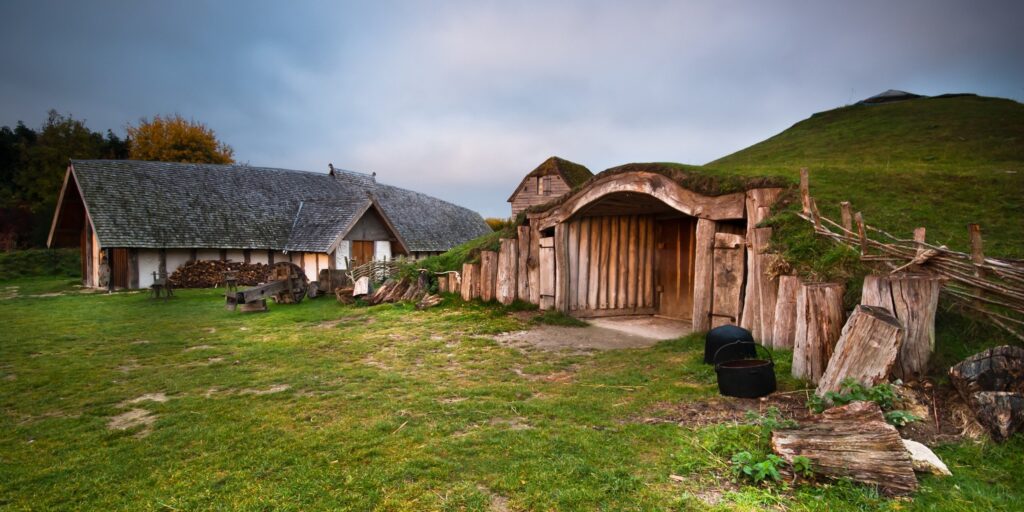
British Museum – London
The Cuerdale Hoard was discovered in 1840 in Lancashire by a workman repairing an embankment of the River Ribble near Preston. The hoard of silver is considered the largest Viking hoard ever found.
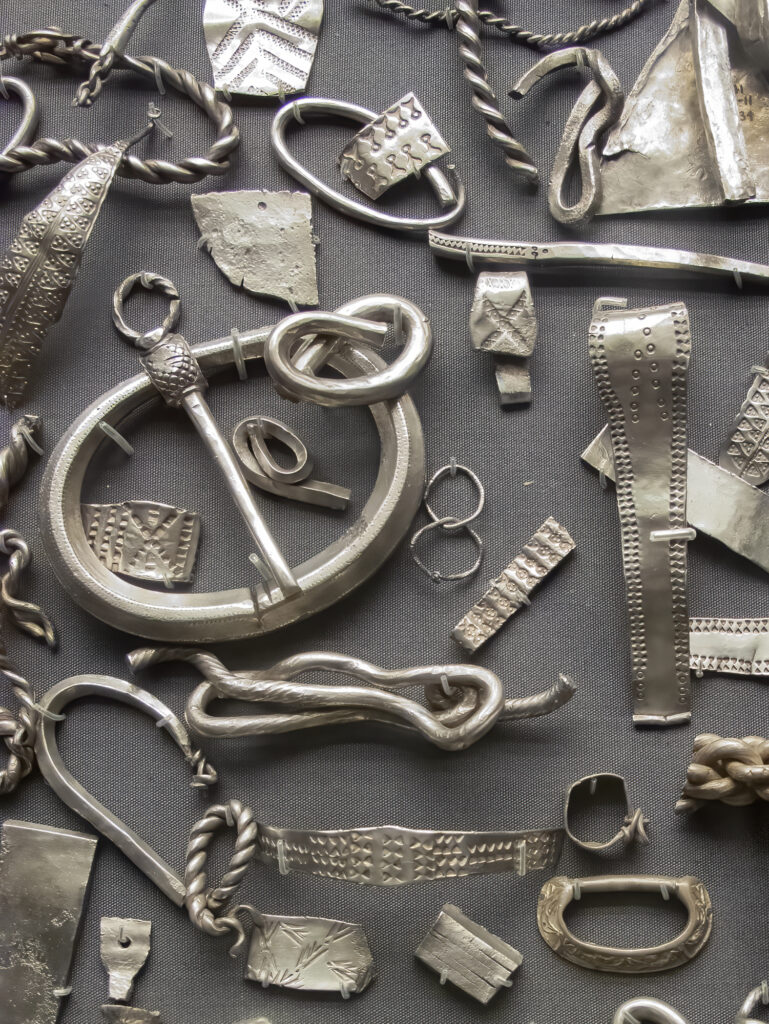
The Cuerdale Hoard contained over 7000 coins and 30 kg of bullion and was thought to have been buried around 905AD. Theories around its contents suggest that perhaps it was a war chest collected by Vikings who had been expelled from Dublin which was linked by the Ribble Valley a route between the Irish Sea and Viking York.
The Ashmolean Museum – Oxford
The Watlington Hoard was found by an amateur metal detectorist in a farmer’s field in Watlington, Oxfordshire in 2015. It contains 186 coins,15 ingots and seven pieces of jewellery, and is thought to date to sometime after the battle of Edington in 878AD which Alfred the Great won over the Vikings. You can see the hoard at the Ashmolean Museum in Oxford.

The most remarkable find is the ‘Two Emperors’ penny, of which there are 13 examples. The coins depict two emperors (thought to be Alfred the Great and the lesser-known Ceolwulf, the last king of Mercia) ruling side-by-side.
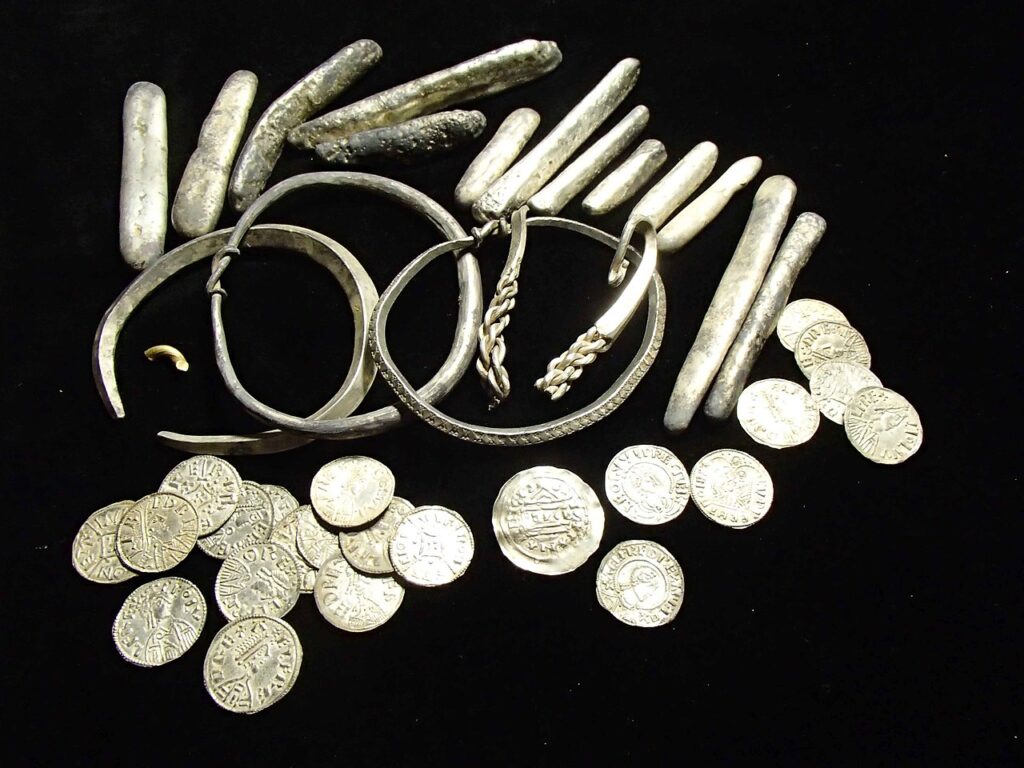
Viking burial ground Derbyshire – The Repton warrior
The body of the Repton Viking Warrior was found in the 1980s and is probably the best-known Viking burial in England. The ninth-century warrior was found with a cut to his leg which apparently also damaged or cut off his privates. The Warrior was found side-by-side with a younger man in the village of Repton.

Recent DNA analysis has revealed that the pair were first-degree relatives, which gives legitimacy to the theory that the warriors were leaders or Viking royalty in the area. The area also revealed 264 other Viking warriors in the burial ground which archaeologists are now certain that was from the first large-scale invasion of England by the Vikings.
Viking weaponry and artefacts on-site were also found on-site and they include a number of knives, 5 silver coins and an axe. You will find these artefacts on display at the Derby Museum in Repton, Derbyshire.
Norwich Castle Museum
The Norwich Castle Museum houses one of the largest and best collections of Anglo-Saxon and Viking materials in the UK including Britain’s largest collection of Thor’s hammers, numerous types of Viking brooches, swords, ingots, weights and all sorts of other materials.
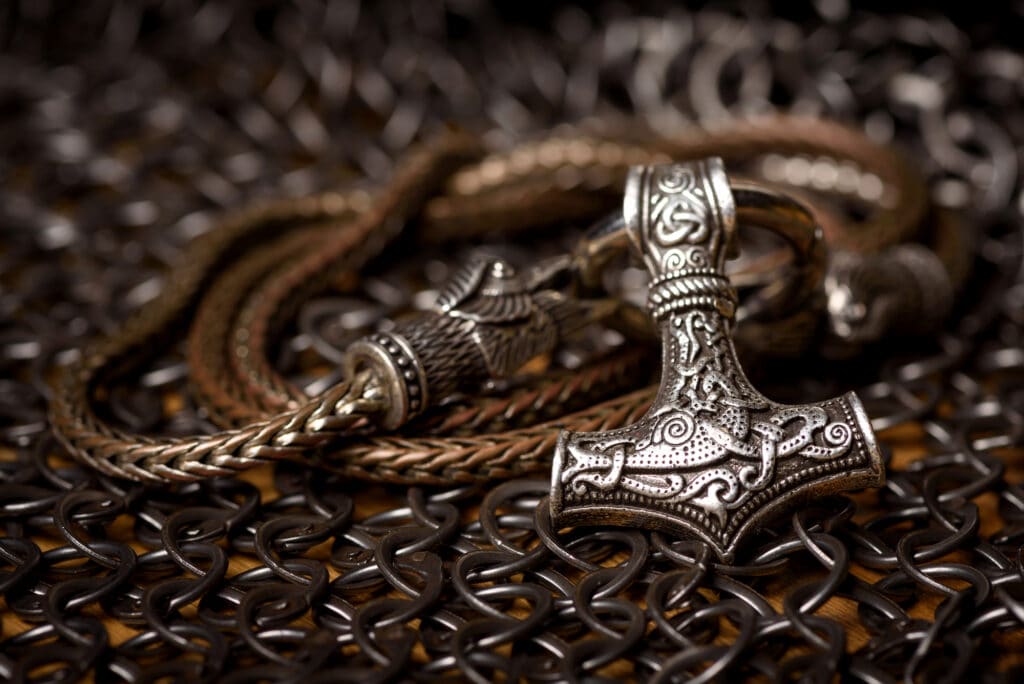
The Hugin Viking Longship – Kent
The Vikings travelled from their Scandinavian homelands aboard great wooden longships. In 1949, a Danish-built replica sailed to England, where it was left as a gift from the Danish government to commemorate the 1500th anniversary of the legendary arrival of the Jutes Hengist and Horsa to Britain’s shores.
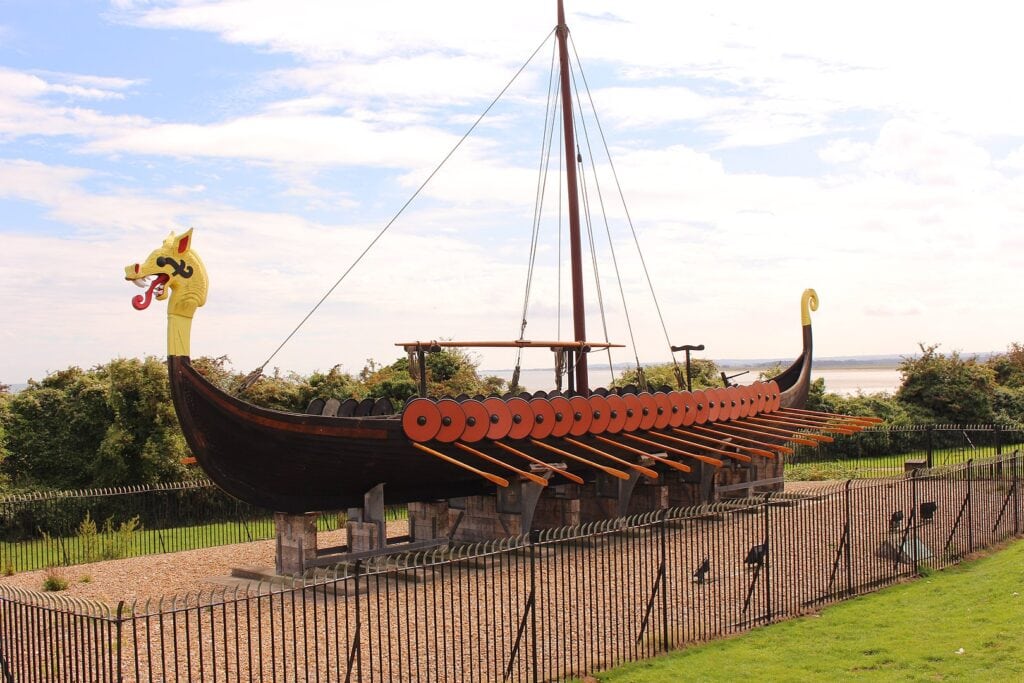
The longship, named Hugin after one of Odin’s ravens, is now stationed on dry land in Ramsgate, Kent.
Vikings in Scotland
The Viking invasion of Britain also involved raids and attacks on Scotland. Scotland’s history of Vikings is a rich thousand-year story when the first Norsemen crossed the seas from Norway during the eighth century and landed on the Northern isles.
The Norsemen first crossed the sea from Norway in the eighth century, and quickly settled throughout Shetland, Orkney, the Hebrides, the Firth of Clyde and in the Northern mainland Caithness.

The Lewis Chessmen – Isle of Lewis
This medieval chess set was discovered in the sand dunes of the Isle of Lewis in the outer Hebrides in 1831. Today, 82 pieces are owned and exhibited by the British Museum in London, and the remaining 11 are at the National Museum of Scotland in Edinburgh.
This is a medieval chess set that is thought to be from at least four different sets and is believed to have been made in the 12th century in Norway but nobody knows for sure.

The set is carved from walrus ivory and whale teeth but does not date to the Viking period. The set of chess pieces includes a rook in the shape of a Viking berserker the legendary Viking warrior who was associated with Odin.
Perhaps the set was carved to honour the Viking ancestors of the Scottish people in the North. Viking genetics are according to DNA research is widespread in Northern Scotland – 29.2 per cent of descendants in Shetland have the DNA, 25.2 per cent in Orkney and 17.5 per cent in Caithness but the percentage drops as low as 9 per cent in the South-west of Scotland.
Underhoull – Unst Shetland Islands
Unst is large and is one of the furthest east and the most northerly of the Shetland Islands and it is believed that this is where the Vikings first landed.
Unst is one of the richest Viking heritage sites in Europe, with over 60 longhouses you can visit that were uncovered by archaeologists at Underhoull, Belmont and Hamar. At Underhoull there are the remains of Viking longhouses which were excavated in 1960 and again in 1980.
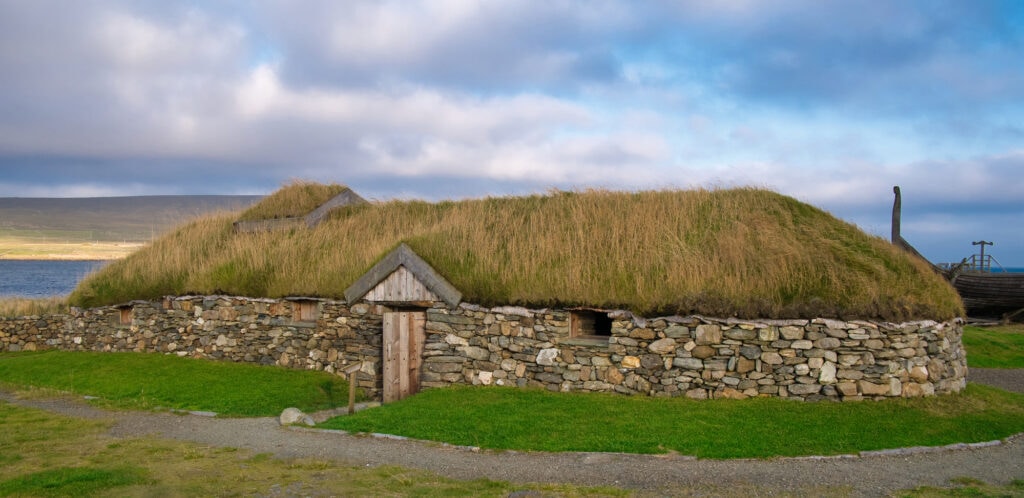
Skidbladner replica longship – Haroldswick
In Haroldswick, a sheltered bay on the east side of the island which is believed to have been named after King Harald Fairhair there is a replica Viking longship called the Skidbladner. The replica is of a longship found in Norway in a burial mound.
Skidbladner has massive oars and a beautifully carved figurehead. A set of wooden stairs allows visitors to climb on board the longship easily. Living history demonstrations take place onboard to enhance the visitor experience.

The Skidbladner now sits alongside the re-constructed longhouse as a permanent visitor experience. The aim is to provide seasonal events and activities around both fixtures during the summer months.
Dim Riv – Lerwick Shetland
Over forty years ago, a replica Viking longship was built, called the Dim Riv and it is a focal point of the waterfront in Lerwick. Run and crewed by volunteers you can take a trip around the harbour on the ship in the summer months.

Jarlshof – Shetland
Jarlshof is a Norse settlement in Shetland where the Vikings came in the ninth century. The Norse longhouse excavated here was the first of its kind found in the UK.
The site was found in the 1890s when storms tore open the low cliffs and revealed the settlement which contained over 4000 years of human history.
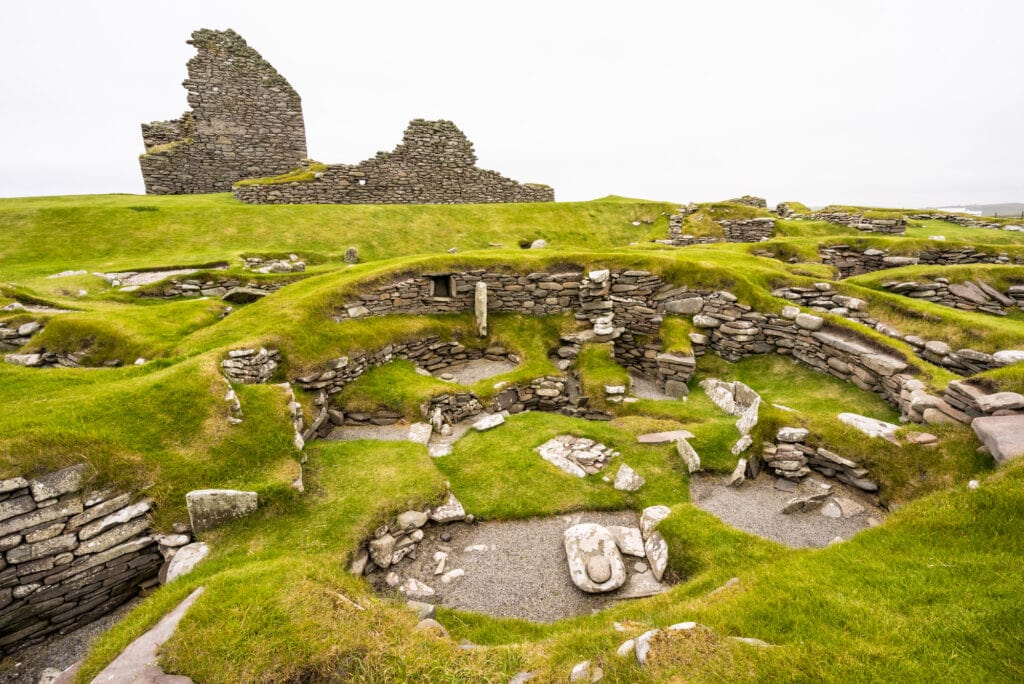
When excavation began the site contained late Neolithic houses, a Bronze-Age village, Iron-Age broch and wheelhouses, a Norse longhouse, a medieval farmstead, and a 16th-century laird’s house. The excavations also produced a wonderful array of artefacts. Jarlshof are all being considered for UNESCO World Heritage Designation
Up Helly Aa – Lerwick
Up Helly Aa is a Viking fire festival held in the Shetland Isles each year. Created in the Victorian era the Festival lasts for 24 hours and is held on the last Tuesday of January every year.
This Scottish Viking wild party is, run entirely by volunteers, lasts just one day and night and is organized by thousands. Much of the preparation is in strictest secrecy. The biggest secret of all is what the head of the festival, the ‘Guizer Jarl’ who represents the Viking chief, will wear and which character from the Norse Sagas he’ll represent.
In Lerwick, around 1,000 men descend on the streets in fantastic costumes. They all wore Viking costumes and only men have been allowed to take part.

Given that recent research has uncovered evidence of female Viking warriors, and that the Norse Sagas (characters from which the Jarls embody) feature prominent women, the event’s exclusionary custom seems to better reflect the values of the Victorian era from which it emerged.
There are Up Helly Aa celebrations from Sumburgh in the South Mainland to Norwick in Unst most of which are far more inclusive than Lerwick’s.
Old Scatness – Shetland
In the 1970s Old Scatness was discovered by workers building an airport road. The site has turned up a number of Viking Artifacts and is now being considered as a UNESCO World Heritage Site.
Years of excavation revealed an Iron Age broch (house), and a post-broch village built around it. Five Pictish (later Iron Age) structures were built into the top of this Middle Iron Age village, some of which have now been removed.

On top of the excavated Pictish buildings, Viking soapstone artefacts and the remains of a Viking floor and hearth indicated that occupation continued into the Norse period. Old Scatness, therefore, provides archaeologists with a rare opportunity to understand the elusive Pictish-Viking transition in Shetland.
National Museum of Scotland – Edinburgh
The National Museum in Edinburgh contains a vast selection of Viking artefacts including the Galloway Hoard. This hoard contained over 100 pieces of gold and silver and was found near the Church of Scotland land at Balmaghie in Kirkcudbrightshire in 2014 by a metal detectorist.
Alongside over five kilograms of silver bullion, composed of arm rings and ingots, the Hoard includes the largest and most varied collection of Viking-age gold objects known from Britain and Ireland.
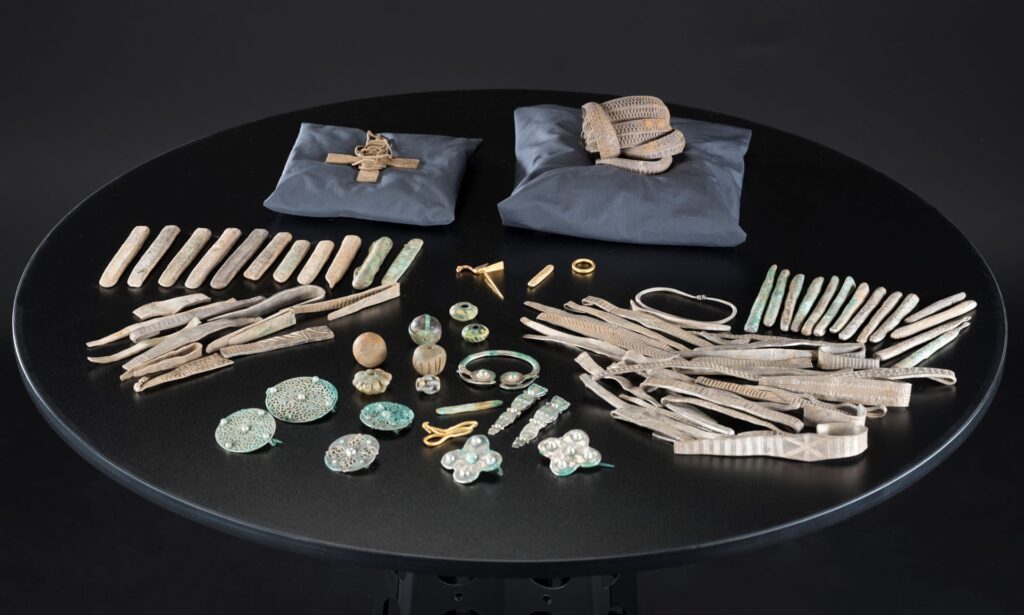
Some of the unusual objects found include a silver pendant cross; a unique gold bird-shaped pin; a decorated silver-gilt lidded vessel; a large collection of Anglo-Saxon metalwork with two examples of an entirely new type of Anglo-Saxon cross-shaped brooch and unique multi-hinged straps; three golden jewels often referred to as ‘aestels’, in a silken-cord bundle; and a gold-mounted rock-crystal flask or jar contained in a silk-lined pouch.
Iona
Iona is a tiny island off the southwest coast of Mull in the Inner Hebrides and the Irish monk Columba established an Abbey here. The churches and monasteries within its grounds became tempting targets for Viking raiders, resulting in several attacks coming from the Viking longships.
The first assault on Iona Abbey occurred in 795, followed by subsequent raids in 802, 806, and 825. During the devastating Viking attack in 806, a tragic event took place in Martyrs’ Bay, where 68 monks were mercilessly slaughtered. Consequently, many of the surviving monks relocated to a new religious center called the Abbey of Kells in Ireland.
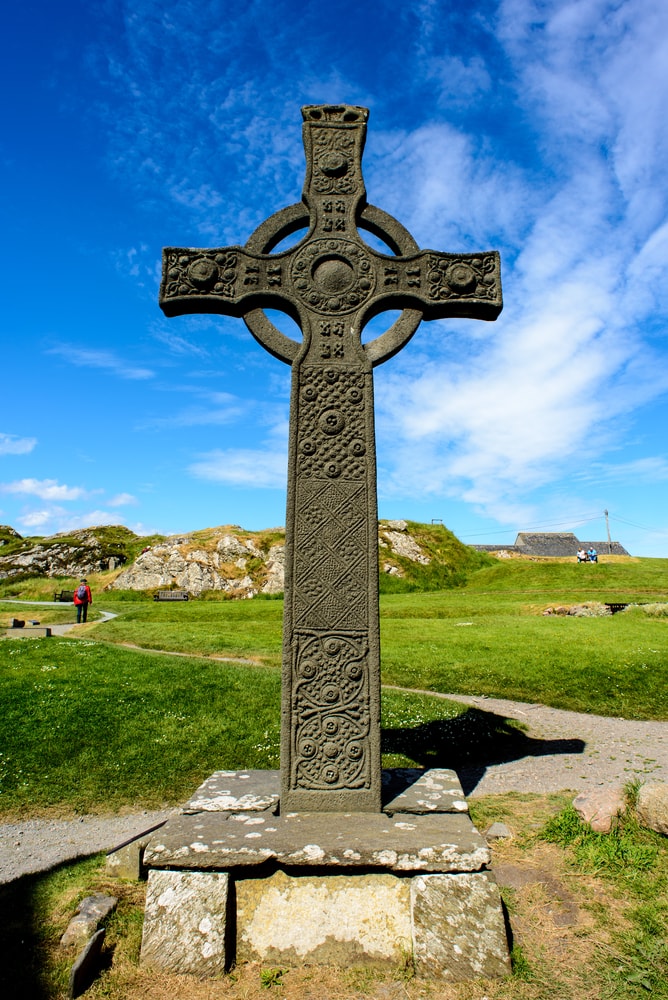
Adomnán, the Abbot of Iona, who died in 704, mentioned the presence of similar freestanding wooden crosses encircled by rings, which were later replaced with stone versions. Presently, the remains of four stone “high crosses” can be found on Iona, dedicated to St. Martin, St. Matthew, St. John, and St. Oran. Among them, St. Martin’s Cross, crafted between 750 and 800, remains intact and in its original location. Nearby stands a replica of St. John’s Cross, while the original, along with the reconstructed St. Oran’s Cross and St. Matthew’s Cross, is exhibited in the Museum within the abbey.
Vikings in Wales
Over the years historians and archaeologists have debated whether or not the Viking invasion of Britain included Wales. Vikings did come to Wales and there is some evidence that Vikings were in Wales thanks to a number of Scandinavian place names such as two small islands of the coast of South Wales Ramsey and Skomer.
In North Wales, the names Anglesey and Bardsey are Norse based. This does not indicate settlements but might just be trading areas.
Llanbedrgoch – Anglesey
The recent excavation of a site at Llanbedrgoch on Anglesey was expanded significantly in the ninth and tenth centuries, including the construction of a wall enclosing the site in the second half of the ninth century, possibly reflecting a concern with Viking raids.
Archaeologists have excavated several objects that may be of Viking origin such as arm rings but they also found a number of objects including Anglo-Saxon pennies and a glass bead. Again this could possibly mean that Llanbedrgoch was simply a trading post but historians believe that given the number of objects found it is possible this was a Viking settlement.
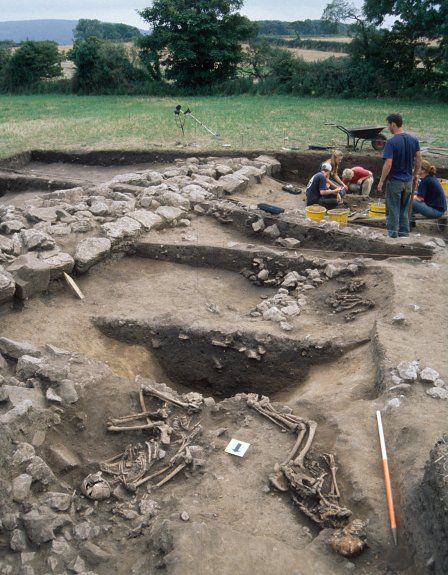
Although Wales did not experience significant Viking settlement the country did experience constant raids from the Norsemen of Dublin and Waterford.
Large-scale settlement by the Vikings in Wales was prevented by Kings like Rhodri the Great and Hywel the Good who fought off the invasion of the Vikings from 844 to 950 AD.
11 of the best Castles in Wales to visit
Viking Settlements & Colonies in Wales
Historians and archaeologists widely agree that there were colonies on both sides of the Milford haven fjord. It is widely accepted that a colony of Scandinavians settled on both sides of the great fjord of Milford Haven in South Pembrokeshire.
There may also have been a Norse colony in Gower, and another Scandinavian settlement in Wales was situated in the low-lying coastal plain between Neath, Cardiff, and Newport, which was a part of the kingdoms of Morgannwg and Gwent. These settlements have uncovered no finds but the names recorded were definitively Scandinavian.

Vikings in Northern Ireland
Larne
Larne, on the Causeway Coast, was known in Old Norse as Ulfreksfjordr. Larne is a coastal seaport and in the 10th-11th centuries was a centre of Viking activity. Several Viking burial sites and artefacts were found in this area that could be dated to that particular time period. Snorri Sturluson mentions Ulfreksfjordr in his Heimskringla as the place where the king of Ireland, Connor, defeated the Orkney Vikings under the leadership of earl Einar in battle in 1018.
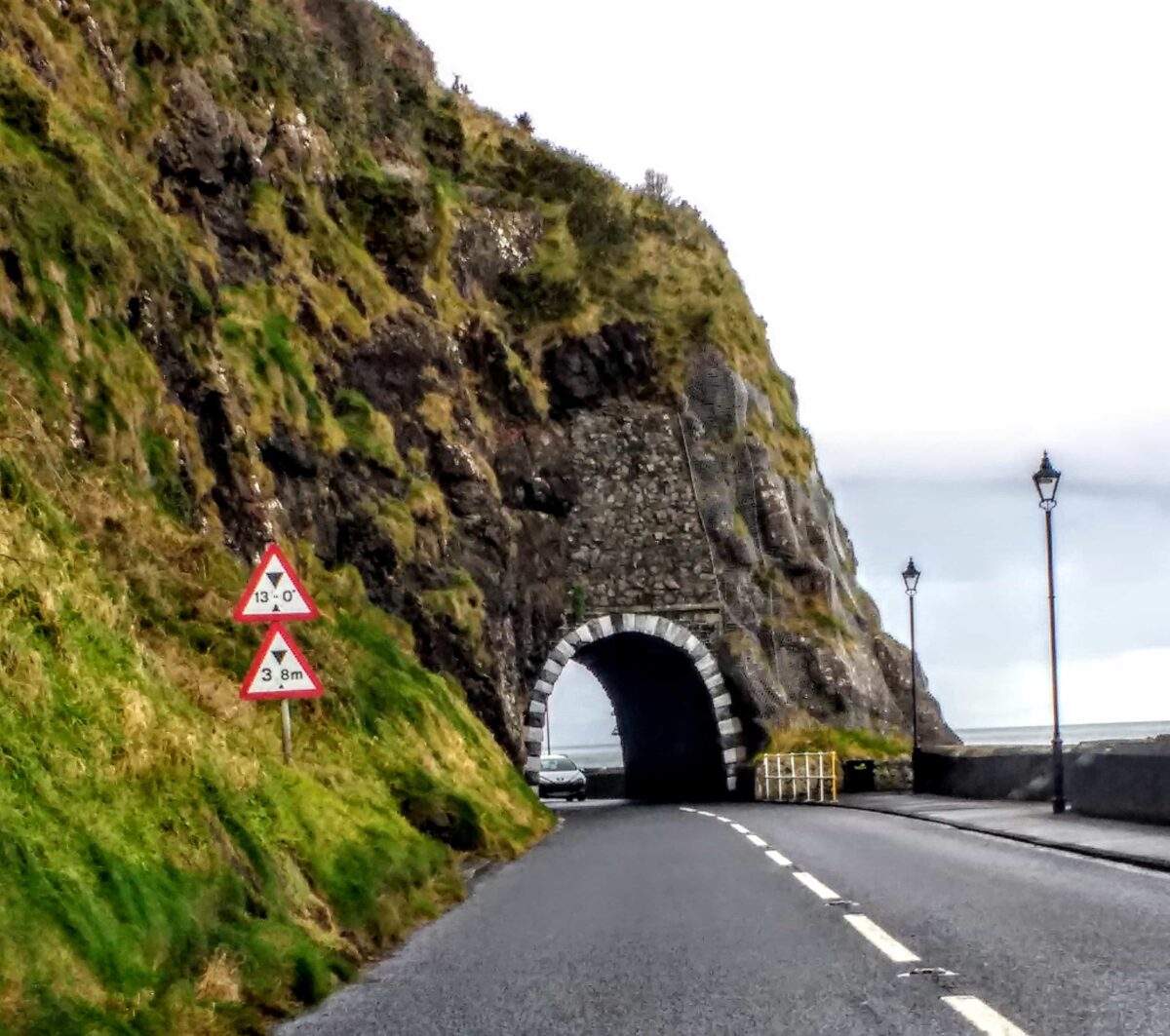
Visit all the HBO TV Show Vikings sites in Ireland – a guide to all the filming locations of Vikings
Rathlin Island
Rathlin Island was the first recorded site of a Viking raid in Ireland in 795, according to the Annals of Ulster. The church on the island was plundered and burned. Overlooking Church Bay you will see a Viking standing Stone which marks a Viking graveyard that was excavated in 1784.
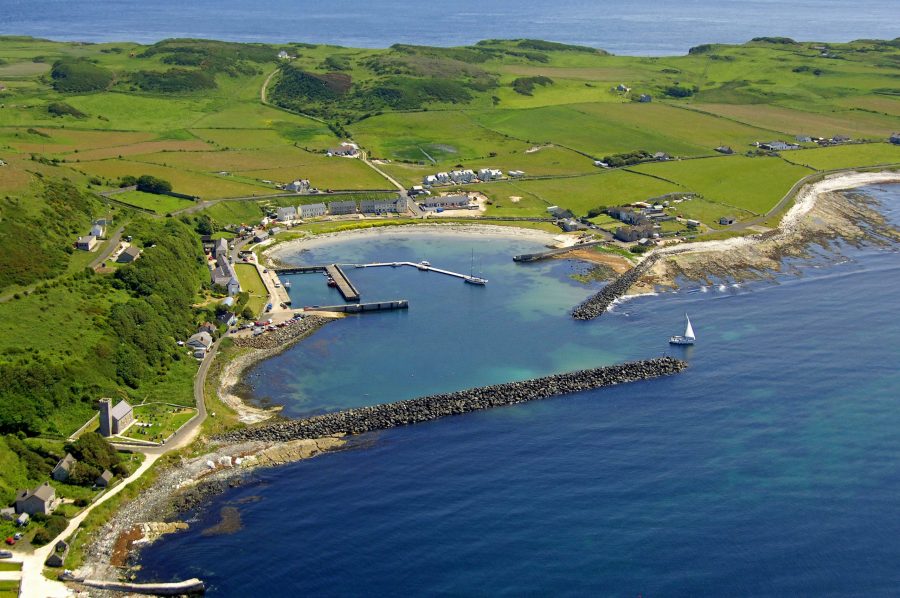
Each grave was formed from slabs of stone and then covered with a flat stone to mark the grave. A large silver penannular brooch was found in the grave marked with the standing stone. This Rathlin Brooch as it is called was probably made by a Viking in the late 9th century. You can see the brooch in the National Museum of Ireland in Dublin.
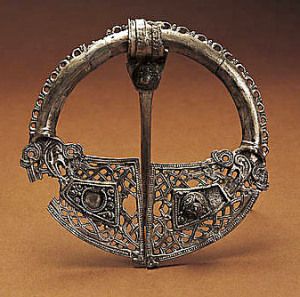
There are probably dozens more Viking UK sites that remain to be discovered. Many of these sites turn up when construction takes place in major Viking raiding locations but it also seems to be a great hobby for metal detectorists to attempt to find a Viking hoard. British Vikings that stayed and settled all over the UK integrated into the local communities and many became Christian but maintained links to their heritage.
The genetic legacy of the Viking Age lives on today with six per cent of people of the UK population predicted to have Viking DNA in their genes compared to 10 per cent in Sweden.
You might also like
22 of the Best English cities to visit
Touring the extraordinary Scottish Highlands – 42 Places to visit
Things to do in Dumfries exploring a literary heritage
The 13 most Interesting Things to do in Inverness, Scotland
Journey to the Black Isle of Scotland the amazing mysterious isle
The 13 most Interesting Things to do in Inverness, Scotland
Witch Trials in England: 33 Witch Sites to Visit

